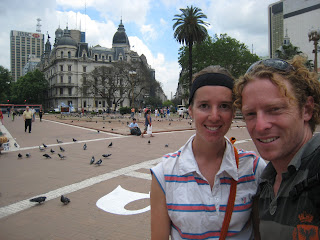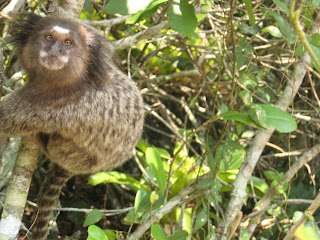Enter Patagonia - Puerto Madryn
October 26-29, 2007
Patagonia got its name because it is the land of people with big feet. Random piece of trivia to begin the blog...
Puerto Madryn was one of the first places to be settled in Patagonia, back in the 1800´s by the Welsh. There are still small communities nearby which still have schools that teach Spanish, English and Welsh. We visited one of these towns called Gaiman but didn´t fall for the tourist trap of paying $30 pesos for Welsh tea.
We visited this part of Patagonia not for the Welsh influence but for the unique wildlife in the Parque Nacional Peninsula Valdes.
Every year between June and December hundreds of Southern Right Whales come through the area and the bay off Peninsula Valdes is a perfect area to do a bit of whale watching. Seeing whales is not guaranteed but it´s highly likely and we were lucky to have great weather and plenty of mother and calf whales to choose to watch. It was one of the most amazing experiences we´ve had, being in a small boat with about 50 people and having whales swim right up to us, rolling around playing and bobbing up and down like big blubber in the ocean.
We were also lucky enough to see heaps of guanacos grazing in the bleak desert-like terrain (it reminds us a bit of Pyramid Hill). Guanacos are wild South American camelids, smaller than llamas but bigger than alpacas. We saw Rhea which are very similar to emus and these crazy animals called maras or Patagonian hares. They are massive and are rodents, not lagomorphs like ordinary hares or rabbits. And they can walk or run, they don´t hop!
On another part of the peninsula we saw elephant seals. At this time of year they lie around on the beach losing weight. When they turn up at the start of the spring they can weigh up to 3000kg! They lose between 7-13kg per day. We watched from the edge of the beach as big males searched for a harem of good looking, eager females to mate with. Most of the time there would be another male who would assert his authority and give the loitering male a big dis-allowed!
Our final treat of animal watching for the day was a point where Magellanic Penguins nest. We saw a few but the following day was ´Penguin day´! Punto Tombo is about 150km south of Puerto Madryn and the home of approximately 700,000 penguins. We saw a fair percentage of them sitting on eggs in nests, walking around the headland, standing preening themselves, surfing the waves on the beach, swimming in the ocean, calling their mates from one side of the valley to the other. We were also able to walk amongst them without disturbing their habitat. Seeing penguins on the big screen is good... in real life way better! These Magellanic guys are way bigger than our fairy penguins back home too!
Unfortunately we didn´t see any killer whales (or orcas as they call them here) coming into the beach riding the waves trying to get a seal or two for dinner. It´s a rare occurance at this time of year. We also didn´t see andy armadillos or foxes. They proved too elusive for our skilled animal watching eyes!











































 We climbed another of Rio´s peaks in the evening, called Sugar Loaf, because that´s what it looks like. This time we climbed by cable car. We chased a few monkeys around the hilltop before wittnessing another beautiful sunset, apparently worthy of a round of applause (the second one of these we´ve seen on our travels, the first in the Greek Islands).
We climbed another of Rio´s peaks in the evening, called Sugar Loaf, because that´s what it looks like. This time we climbed by cable car. We chased a few monkeys around the hilltop before wittnessing another beautiful sunset, apparently worthy of a round of applause (the second one of these we´ve seen on our travels, the first in the Greek Islands). 
